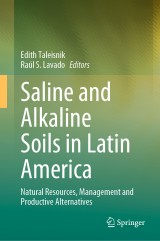Details

Saline and Alkaline Soils in Latin America
Natural Resources, Management and Productive Alternatives|
CHF 118.00 |
|
| Verlag: | Springer |
| Format: | |
| Veröffentl.: | 26.09.2020 |
| ISBN/EAN: | 9783030525927 |
| Sprache: | englisch |
Dieses eBook enthält ein Wasserzeichen.
Beschreibungen
<div>This book provides the first comprehensive overview of saline and alkaline soils in Latin America, known for having one of the most extensive surface of salt-affected soils in the world. It is organized along two main axes: soils and vegetation. The book discusses the occurrence of such soils in the region, focusing mainly in management strategies for their sustainable use, and it presents accounts of natural vegetation and crops in the various environments of the region. Social impacts of such conditions and ongoing projects to overcome them are considered. Likewise, the book highlights physiological mechanisms that are responsible for the negative effects these soils exert on crops and forest resources and determine vegetation distribution in them. Plant breeding challenges and new perspectives for such environments are discussed. Technologies such as irrigation and drainage are included. The readership includes soil and plant scientists, as well as policy makers.</div>
Chapter 1. Overview of salt and alkali-affected areas in Latin America. A physical and social perspective.- Chapter 2. Salt affected environments and soil and crop management in different agro/ecosystems.- Chapter 3. Genesis and properties of salt affected soils in the Flooding Pampa.- Chapter 4. Dryland salting in the Chaco forest.- Chapter 5. Salt-affected soils of Pantanal wetland: characterization, genesis and mineralogy.- Chapter 6. Problems of salinity and sodicity related to irrigation and drainage in Venezuela, Colombia, Cuba and Dominican Republic.- Chapter 7. Sea water intrusion and its effects of groundwater in Cuba.- Chapter 8. Soil salinization at the northern coast of Peru: A study case in San Pedro de Lloc.- Chapter 9. Characteristics and management of halo-hydro-morphic soils in North Santa Fe province, Argentina.- Chapter 10. Soil-water-plant management in Brazilian areas affected by salts.- Chapter 11. Conceptual basis and guidelines for the ameliorative use of gypsumin salt affected soils.- Chapter 12. Management of cattle grazing in humid marshlands.- Chapter 13. Management technologies and reclamation of salt affected and flooded soils in the Pampas.- Chapter 14. Effects of supplementary irrigation on soils and crops in humid and subhumid areas in the Pampas region.- Chapter 15. Strategies for the use of saline water in Northern Brazil.- Chapter 16. Salinity influences arsenic resistance in the northern Chile.- Chapter 17. Effects of salinity on vineyards in North Mendoza province.- Chapter 18. Plant resources from saline soils and their contribution to ecological sustainability.- Chapter 19. Salt and alkali tolerance mechanisms in the major crops and forage plants cultivated in Argentina.- Chapter 20. The search of native forage resources from saline soils.- Chapter 21. Phytoremediation and revegetation of saline sodic soils in Brazil.- Chapter 22. Native plants in the productive restoration and reclamation of saline environments in arid zonesof Argentina.- Chapter 23. Brazilian halophites and the biosaline agriculture.- Chapter 24. Genetic improvements of forages for salt tolerance.- Chapter 25. <i>Lotus</i> spp: Biotechnological strategies to improve the bioeconomy of agricultural marginal environments in the Flooding Pampa.
<div>This book provides the first comprehensive overview of saline and alkaline soils in Latin America, known for having one of the most extensive surface of salt-affected soils in the world. It is organized along two main axes: soils and vegetation. The book discusses the occurrence of such soils in the region, focusing mainly in management strategies for their sustainable use, and it presents accounts of natural vegetation and crops in the various environments of the region. Social impacts of such conditions and ongoing projects to overcome them are considered. Likewise, the book highlights physiological mechanisms that are responsible for the negative effects these soils exert on crops and forest resources and determine vegetation distribution in them. Plant breeding challenges and new perspectives for such environments are discussed. Technologies such as irrigation and drainage are included. The readership includes soil and plant scientists, as well as policy makers.</div>
First comprehensive account of this topic in Latin America Provides case studies of saline and alkaline soils First-hand new technological management tools Presents natural plant resources management and breeding strategies
Diese Produkte könnten Sie auch interessieren:

Contaminated Soils, Sediments and Water:

von: Edward J. Calabrese, Paul T. Kostecki, James Dragun

CHF 177.00















